Massive School of Tuna Surround Diver
Scuba diving is one of those sports that can open up a whole new world to its athlete. Travel and experience are a couple of the activities that diving brings to many that take up the underwater activity. Learning to dive takes little more than the ability to swim, and taking a few weeks out of ones busy schedule to take a course at a local scuba diving shop. After learning the basics of the equipment and how it works as well learning how to maintain the gear, it is off to the pool. Some basic skills for a newcomer can prove to be a little challenging at first, but in no time it all becomes second nature. Safety is the main priority, and should never be jeopardized. Brent the videographer in this video explained his training somewhat like this. “I always liked being in the water, but not being a very strong swimmer I always thought I could not dive”. After doing some research into local shops that offered the course, he was set to go.” We had booked a trip to Mexico for my 50th birthday and I wanted to finally dive but planned on finishing the course in warm waters as I don’t like the cold !” Well during one of the first nights of class training, Brent was told ” well we will see about that!” In reference to completing the course away from his home town. He was told that learning to dive in the green waters of British Columbia are challenging since visibility at times can be greatly reduced, but it does produce a better diver in the long run. Brent did complete his training in the local, green, cold waters that near 42 degrees Fahrenheit. Since that day, Brent and his wife have travelled and dove in Australia, Mexico, Grand Cayman Islands and Belize in the Caribbean.They also continue to be active in their local waters. In this video you will see just one of the amazing occurrences that divers love to see. This took place in Cabo Pulmo, Mexico on the Sea of Cortez. Dropping over the side of the panga, Brent and Elsa were amazed at the site in front of them. Thousands and thousands of small tuna, called Jacks. They were tightly grouped together from within feet of the surface, right to ocean floor some 70 feet below. While doing this to protect themselves from some predators, it also can be detrimental to the fish. Larger predators can also sense these bait balls which gives them a perfect opportunity for a large meal. Whales, sharks, and some bill fish take advantage of these bait balls. For divers it is the amazing sight of seeing thousands of fish swimming in unison, so large they even create a shadow over the divers. Blocking out the natural light from the blazing sun above the waves, it shows just how many and how tightly grouped these Jacks are. What an experience!
-
 1:12
1:12
WildCreatures
4 years ago $0.43 earnedYoung diver experiences the thrill of being inside a bait ball
2.69K2 -
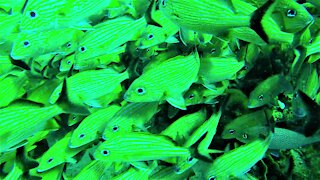 0:34
0:34
BigSexysPlayground
3 years ago $1.11 earnedScuba diver swims through a school of beautiful tropical fish
1.5K3 -
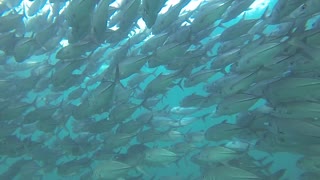 0:47
0:47
Jam3sCow3n
6 years agoScuba Diver Swims Among Massive School Of Fish
409 -
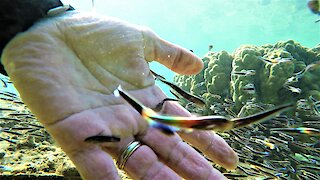 1:29
1:29
WildCreatures
4 years ago $12.85 earnedThousands of "friendly" little fish are actually eating this diver
12K1 -
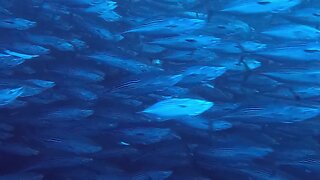 1:21
1:21
WildCreatures
1 year ago $38.07 earnedScuba diver becomes completely disoriented in gigantic tuna bait ball
8.24K20 -
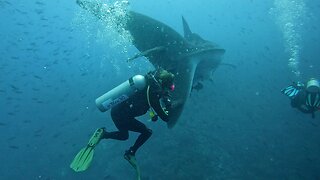 0:28
0:28
GalapagosGuys
1 year ago $189.42 earnedGigantic tail of passing whale shark nearly clobbers scuba diver
8.44K18 -
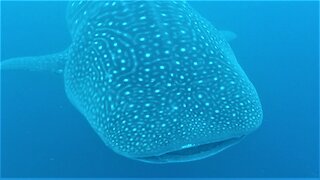 0:42
0:42
WildCreatures
5 years ago $31.69 earnedMassive whale shark swims directly under surprised scuba diver
13.5K5 -
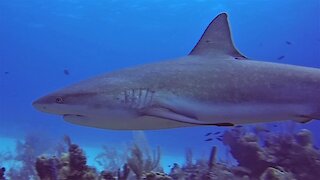 0:49
0:49
WildCreatures
4 years ago $22.36 earnedDivers in Belize find themselves surrounded by big sharks
2.89K1 -
 1:03
1:03
GalapagosGuys
3 years ago $25.08 earnedGigantic whale shark swims right over scuba diver
9.72K10 -
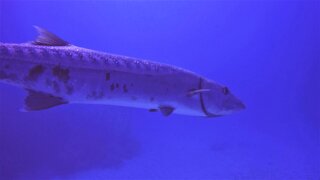 1:58
1:58
WildCreatures
4 years ago $8.78 earnedScuba diver casually swims along within inches of two gigantic barracuda
7.23K10